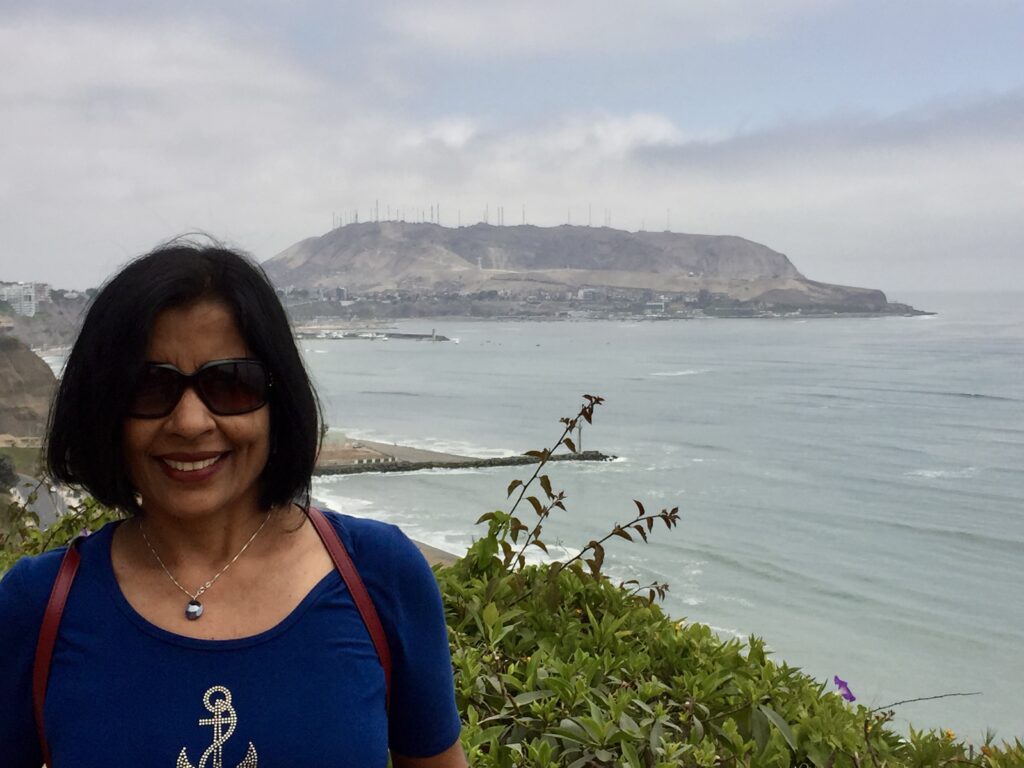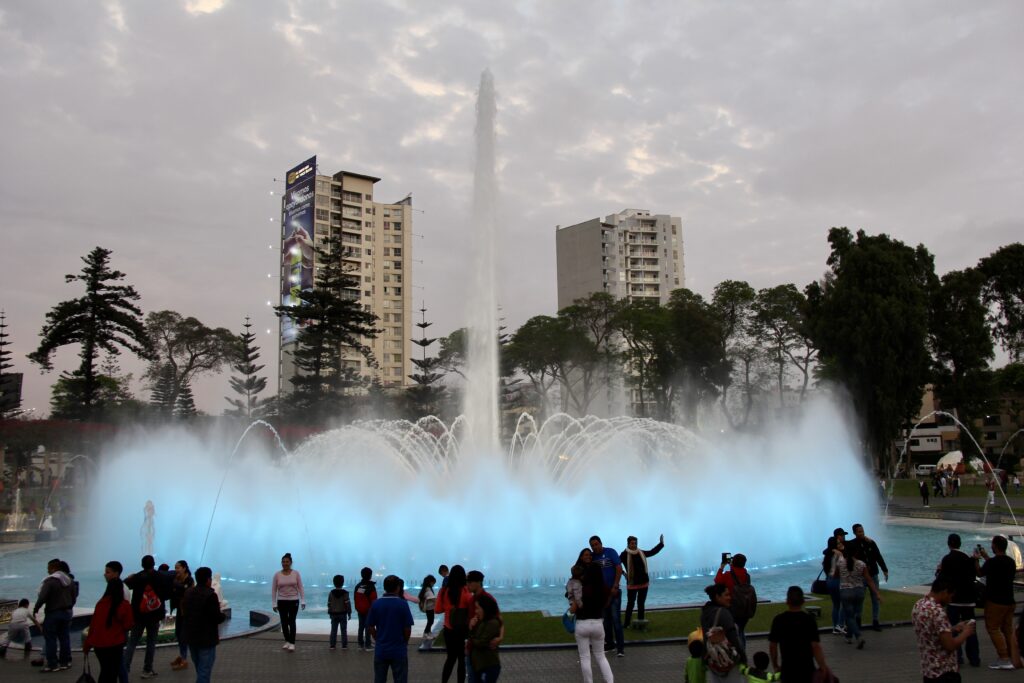After checking into our hotel and freshening up, we took a taxi to Miraflores neighborhood.
Huaca Pucllana – In the heart of the urban center of Lima sits Huaca Pucllana. (“Huaca” meaning “pyramid” or “temple” in Quechua). The inhabitants of the area who built the pyramid lived 200 AD to 700 AD. Huaca Pucllana itself, however, was built around 500 AD. The process of uncovering Huaca Pucllana began in 1981 and in 1991 it became a historical and cultural park. Built of adobe and clay bricks – a construction material that would never have survived for more than 1,000 years in any other climate – the pyramid is formed in seven staggered platforms. From artifacts discovered here, it is known to have been important as both a ceremonial and administrative center. The area is divided into two sections, one of which shows evidence of being used for offerings of fish, while the other appears to have been administrative. A burial vault was uncovered here with human remains, and artifacts have been found from the later Wari culture, which thrived in this area from about AD 500 to 900. One must tour the complex with a guide. Open 9am – 5pm and we paid $4 in 2018 to visit this place.




The site also has a museum that houses and displays the remains and artifacts discovered in the ancient pyramid of the Lima culture.


Miraflores – We then walked to Larcomar, a shopping mall overlooking the Pacific coast, located in Miraflores, and is very popular among tourists, young people, and the middle and upper classes. There are restaurants, stores, a food court, ice cream shops, bars, and the most modern cinema in Lima.



Circuito Magico del Agua (Magic Water Tour) – (3-10:30pm Tue-Sun; $1:50; shows@7:15pm) – The Magic Water Tour was opened in the Park of the Reserve in 2007. It holds the record for the largest fountain complex in the world, with 13 separate fountains. The largest, the Fuente Mágica, shoots a jet of water more than 80 meters high, while the Fuente Túnel de las Sorpresas (Tunnel of Surprises) is a 35-meter tunnel of water to walk through. All the fountains are illuminated in the night with changing colors.





Barranco – Artsy neighborhood with some beautiful 19th and early-20th-century architecture. The area wasn’t always part of the city and was originally a getaway for Lima residents. Today, the neighborhood exudes art and color with boldly painted buildings and murals brightening public spaces.

Plaza de Armas – Also called Plaza Mayor, this broad square is the historical center of Lima. Most of the original buildings in the plaza were lost in the earthquake of 1746 – the only original structure standing in Lima’s Plaza de Armas is the bronze fountain in the center, built in 1651. Some of the buildings in the plaza are the Archbishop’s Palace, Palacio del Gobierno, and the Lima Cathedral.
Archbishop’s Palace – Opened in 1924, this building was allocated to be the residence of the head priest of Lima. The facade is made up of baroque elements, completely made of reintegrated rock; ornate cedar balconies are located over the main doors.

The interior of the palace is highly decorated and the ceiling is illuminated by stained glass windows. The interior also contains marble staircases with wooden handrails which allow access to the second story.




Lima Cathedral – Lima’s cathedral dominates the east side of the Plaza de Armas. Construction began on the original cathedral in 1535, and it was enlarged in 1564, based on the design of the cathedral in Seville, Spain. It was damaged by an earthquake in 1687 and almost destroyed by the big quake of 1746 but was quickly rebuilt to its present appearance. Look for the outstanding carved choir, a carving of Jesus in the chapel of St. John the Baptist, and the altars in the ornate Spanish Baroque style known as churrigueresque. A chapel decorated in mosaics holds the tomb of Francisco Pizarro, the founder of Lima.




Palacio del Gobierno – Official residence of the president that was built on the spot where Jose San Martín declared the Independence of Peru on July 28, 1821. You can see the changing of the guard there on weekdays at noon. The building, occupies the northern side of the Plaza Mayor.

Plaza San Martin – The pedestrian-only Jiron de la Union, leading from Plaza de Armas to Plaza San Martin, is a mix of old and new buildings housing restaurants and shops. Here, you’ll find La Merced church, which was completed in the late 1700s and has an ornate Baroque colonial façade.


Convento de San Francisco – The San Francisco church and monastery were consecrated in 1673 and it is one of the city’s best preserved colonial churches, having withstood the earthquakes of 1687 and 1746, although it did suffer extensive damage in a quake in 1970. The San Francisco church is also famous for their catacombs and Library. Below the church is a maze of narrow hallways, each lined on both sides with bones. In one area, a large round hole is filled with bones and skulls arranged in a geometrical pattern, like a piece of art. The library, on the upper level, has thousands of antique books, and the monastery has an impressive collection of religious art.


Basilica and Convent of Santo Domingo – Built in 1540, the church and monastery of Santo Domingo is one of the oldest and most historic in Lima.


Lima in the night – We hung out until nighttime in Miraflores watching the sunset and then the lighted cross. The cross was built to commemorate the Pope’s visit, and is a very beautiful sight. Best seen from Larcomar, rather than closer up.

